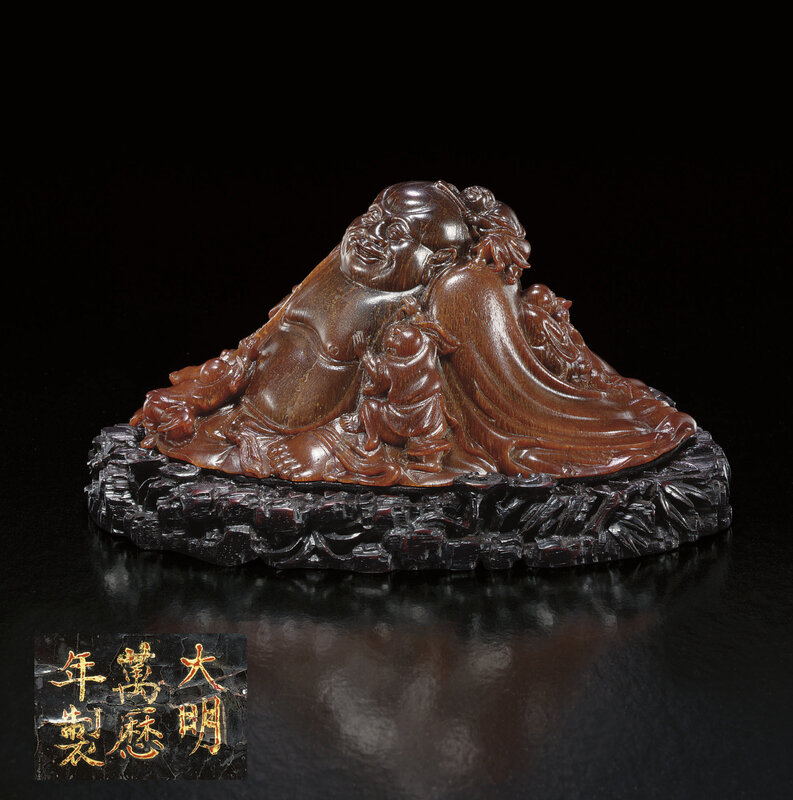A rare and finely carved rhinoceros horn figure of Budai, Wanli period (1573-1620)
Lot 1727. A rare and finely carved rhinoceros horn figure of Budai, Wanli period (1573-1620); 5 7/8 in. (15 cm.) wide. Weight: 9.2 oz. (262 gm). Estimate HKD 4,000,000 - HKD 5,000,000. Price Realized: HK$5,703,500 ($734,058). © Christie's Images Ltd 2008
The smiling figure well carved in the round as Budai, seated amidst the spreading, loose folds of his voluminous robes, his chest and large belly left exposed, clutching a tasselled rosary in his right hand while five laughing boys clamber up his body and play with his bag, robes and ear, the base filled in and covered in reddish-brown lacquer, inscribed in gilt and cinnabar-red with the reign mark within a surrounding keyfret border, the material of caramel tone darkening at the core, box
Notes: Previously sold at Sotheby's New York, 30 March 2006, lot 133.
The monk Budai, also known as the Laughing Buddha, is an incarnation of the Bodhisattva Maitreya, the Buddha predicted to succeed Gautama Buddha in the future. Typically depicted with a joyful expression and wearing loose fitting robes to reveal his plump stomach seated representing contentment and abundance, Budai is also associated with the protection of children and is often shown with small children playfully climbing on his belly or back.
Figural carvings from rhinoceros horn are rare but the most common depictions include Manjusri and Budai . The current carving of Budai ranks among the most impressive and elaborate depictions of the subject matter. A slightly larger but very closely comparable carving of Budai formerly in the Ruth Dreyfus and Arthur M. Sackler collections is illustrated by Thomas Fok, Connoisseurship of Rhinoceros Horn Carving in China, Hong Kong, 1999, p. 117 no.69, and again by J. Chapman, The Art of Rhinoceros Horn Carving in China, Hong Kong, 1999, no. 327 and was sold at Christie's New York, 1 December 1994, lot 28. Another related example formerly in the George and Mary Bloch collection illustrated by J. Chapman, The Art of Rhinoceros Horn Carving in China, Hong Kong, 1999, no. 327, was sold at Sotheby's Hong Kong, 23 October 2005, lot 34.
A rhinoceros horn carving of Budai attributed the late Ming dynasty but lacking a reign mark in the Palace Museum, Beijing is illustrated in The Complete Collection of Treasures of the Palace Museum - Bamboo, Wood, Ivory and Rhinoceros Horn Carvings, Shanghai, 2001, no. 138; and another in the Shanghai Museum, is illustrated in Shanghai bowuguan Jikan, vol. 6, 1992, fig. 28.
Christie's Hong Kong. Important Chinese Rhinoceros Horn Carvings from the Songzhutang Collection. 27 May 2008

/https%3A%2F%2Fprofilepics.canalblog.com%2Fprofilepics%2F1%2F0%2F100183.jpg)
/https%3A%2F%2Fstorage.canalblog.com%2F03%2F02%2F119589%2F96711876_o.jpg)
/https%3A%2F%2Fstorage.canalblog.com%2F11%2F31%2F119589%2F94773502_o.jpg)
/https%3A%2F%2Fstorage.canalblog.com%2F20%2F83%2F119589%2F94772815_o.jpg)
/https%3A%2F%2Fstorage.canalblog.com%2F26%2F72%2F119589%2F75604929_o.jpg)
/https%3A%2F%2Fstorage.canalblog.com%2F59%2F60%2F119589%2F26458628_o.jpg)



/image%2F1371349%2F20240324%2Fob_e3ecaa_1.jpg)
/image%2F1371349%2F20240324%2Fob_ef0abf_1.jpg)
/image%2F1371349%2F20240324%2Fob_64049b_1.jpg)
/image%2F1371349%2F20240324%2Fob_a0994e_1.jpg)